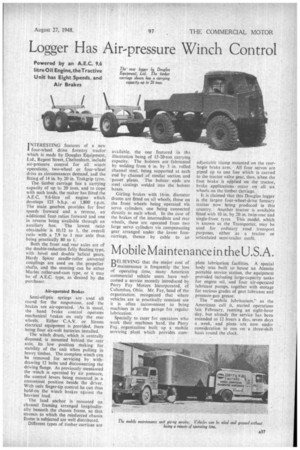Logger Has Air-pressure Winch Control
Page 55

If you've noticed an error in this article please click here to report it so we can fix it.
Powered by an A.E.C. 9.6 litre Oil Engine, the Tractive Unit has Eight Speeds, and Air Brakes
I NTERESTING features of a new four-wheel drive forestry tractor which is made by Douglas Equipment, Ltd., Regent Street, Cheltenham, include air-pressure control for all winch operations, two-wheel or four-wheel drive as circumstances demand, and the fitting of 14 in. by 20 in. Trakgrip tyres. The timber carriage has a carrying capacity of up to 20 tons, and to cope with such loads, the maker has fitted the A.E.C. 9.6-litre oil engine which develops 125 b.h.p. at 1,800 r.p.m. The main gearbox provides for four speeds forward and a reverse, an additional four, ratios forward and one in reverse being available through an auxiliary box. The lowest ratio obtainable is 10.12 to 1, the overall ratio with a 7.9 to 1 rear axle thus being practically 80 to 1.
Both the front and rear axles are of the double-reduction fully floating type, with bevel and double helical gears. Hardy Spicer needle-roller universal couplings are used on the propeller shafts, and the steering can be either Marles roller-and-cam type. or it may be of A.E.C. type, as desired by the purchaser.
Air-operated Brakes Semi-elliptic springs are used all round -for the suspension, and the brakes are air-operated. As is usual, the hand brake control operates mechanical brakes on only the rear wheels. Either C.A.V. or Simms electrical equipment is provided, there being four six-volt batteries installed.
The winch drum, which is centrally disposed, is mounted behind the rear axle, its low position making for stability of the unit when pulling in heavy timber. The complete winch can be removed for servicing by withdrawing 12 bolts and disconnecting the driving flange. As previously mentioned the winch is operated by air pressure, the control levers being mounted in a convenient position beside the driver. With only finger-tip control he can thus hold-on the winch brakes against the heaviest load.
The land anchor is mounted on channel framing arranged longitudinally beneath the chassis frame, so that stresses to which the reinforced chassis frame is subjected are well distributed.
Different types of timber carriage are available, the one featured in the illustration being of 15-20-ton carrying capacity. The bolsters are fabricated by welding from 6 in. by 3 in. rolled channel steel, being supported at each end by channel of similar section and 'gusset plates. The bolster ends are steel castings welded into the bolster boxes.
Girling brakes with 16-in, diameter drums are fitted on all wheels, those on the front wheels being operated via servo cylinders, one being connected directly to each wheel. In the case of the brakes of the intermediate and rear wheels, these are operated from two large servo cylinders via compensating gear arranged under the lower forecarriage, thence by cable to an
adjustable clamp mounted on the rearbogie brake arm. All four servos are piped up to one line which is carried to the tractor valve gear. thus, when the foot brake is 0-plied on the tractor, brake _applications occur on all six wheels on the timber carriage.
It is claimed that this Douglas logger is the largest four-wheel-drive forestry tractor now being produced in this country. Another tractor is available fitted with 10 in. by 20 in. twin-rear and single-front tyres. This model, which is known as the Transporter, may be used for ordinary road .transport purposes, either as a tractor or articulated semi-trailer outfit.




















































































